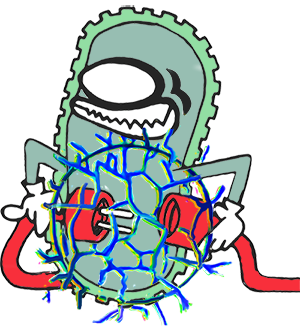Team:TU Delft-Leiden/Project/Life science/curli/theory
From 2014.igem.org
| (11 intermediate revisions not shown) | |||
| Line 6: | Line 6: | ||
<html> | <html> | ||
| - | < | + | <h2>Conductive Curli – Context </h2> |
| - | < | + | |
| - | < | + | |
| + | <div class="tableofcontents"> | ||
| + | |||
| + | <ul> | ||
| + | <a href="/Team:TU_Delft-Leiden/Project/Life_science/curli">Module Conductive Curli</a> | ||
| + | |||
| + | |||
| + | <ul> | ||
| + | <li>Context</li> | ||
| + | <li><a href="/Team:TU_Delft-Leiden/Project/Life_science/curli/integration">Integration of Departments</a></li> | ||
| + | <li><a href="/Team:TU_Delft-Leiden/Project/Life_science/curli/cloning">Cloning</a></li> | ||
| + | <li><a href="/Team:TU_Delft-Leiden/Project/Life_science/curli/characterisation">Characterization</a></li> | ||
| + | </ul> | ||
| + | </ul> | ||
| + | </div> | ||
<p> | <p> | ||
| - | In the Module Conductive Curli we combine the advantages of live bacteria with the benefits of | + | In the Module Conductive Curli we combine the advantages of live bacteria with the benefits of non-living materials. A great advantage of bacteria is their ability to respond to the environment, but unfortunately, they have limited possibility to create new functionality all of the sudden. However, if you would find a way to combine bacteria with nonliving materials, you can choose your material in a way it meets your requirements. A beautiful example of these “living materials” has recently been shown by MIT engineers, who were able to reprogram <i>E. coli</i> in a way in which the bacteria were actually making gold nanowires and conducting biofilms when gold nanoparticles were present [1]. |
</p> | </p> | ||
<br> | <br> | ||
| Line 28: | Line 41: | ||
</figure> | </figure> | ||
</p> | </p> | ||
| - | <p> But how to make these curli conductive and thus make "living material" ourselves? Our curli subunit CsgA carries a histidine tag, which facilitates binding of gold nanoparticles to the curli [1]. The gold nanoparticles on their turn end up in the biofilm, | + | <p> But how to make these curli conductive and thus make "living material" ourselves? Our curli subunit CsgA carries a histidine tag, which facilitates binding of gold nanoparticles to the curli [1]. The gold nanoparticles on their turn end up in the biofilm, increasing the conductivity of the extracellular environment. This change in conductivity is easily measurable on its own, but in combination with the <a href="https://2014.igem.org/Team:TU_Delft-Leiden/Project/Life_science/EET">extracellular electron transport module</a> , it could even result in enhanced extracellular electron transport. |
</p> | </p> | ||
<br> | <br> | ||
| Line 42: | Line 55: | ||
</p> | </p> | ||
| - | |||
| - | |||
| - | |||
| - | |||
</html> | </html> | ||
{{:Team:TU_Delft-Leiden/Templates/End}} | {{:Team:TU_Delft-Leiden/Templates/End}} | ||
Latest revision as of 14:26, 17 October 2014
Conductive Curli – Context
In the Module Conductive Curli we combine the advantages of live bacteria with the benefits of non-living materials. A great advantage of bacteria is their ability to respond to the environment, but unfortunately, they have limited possibility to create new functionality all of the sudden. However, if you would find a way to combine bacteria with nonliving materials, you can choose your material in a way it meets your requirements. A beautiful example of these “living materials” has recently been shown by MIT engineers, who were able to reprogram E. coli in a way in which the bacteria were actually making gold nanowires and conducting biofilms when gold nanoparticles were present [1].
For the CONDUCTIVE CURLI part of the project we induce curli formation in E. coli. Curli are extracellular amyloids that form fibers. They are involved in adhesion, cell aggregation and biofilm formation [2]. The curli pathway involves the so called CsgA-G proteins (see figure 1). CsgA is the major curli subunit, with a CsgB subunit at the beginning of every fiber. CsgE, CsgF and CsgG are non-structural proteins involved in curli biogenesis and CsgD is a transcriptional regulator [3].
But how to make these curli conductive and thus make "living material" ourselves? Our curli subunit CsgA carries a histidine tag, which facilitates binding of gold nanoparticles to the curli [1]. The gold nanoparticles on their turn end up in the biofilm, increasing the conductivity of the extracellular environment. This change in conductivity is easily measurable on its own, but in combination with the extracellular electron transport module , it could even result in enhanced extracellular electron transport.
References
1. Chen et al., Synthesis and patterning of tunable multiscale materials with engineered cells. Nature Materials 13, 515–523 (2014)
2. M. M. Barnhart and M. R. Chapman, Curli Biogenesis and Function. Annu Rev Microbiol. 60, 131–147 (2006)
3. L.S. Robinson et al., Secretion of curli fibre subunits is mediated by the outer membrane-localized CsgG protein. Mol Microbiol. 59(3): 870–881. (2006)
 "
"







